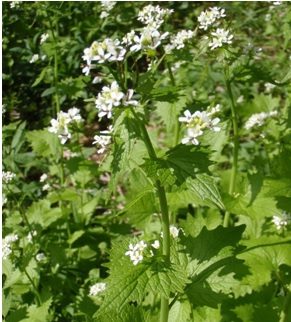Garlic Mustard (Alliaria Petiolata)

Garlic mustard (Alliaria petiolata) is an invasive herbaceous ground cover plant that was introduced to the North America over a century ago as a kitchen herb. It has a two year life cycle where is begins as a basal rosette its first year of growth and then experiences rapid growth in the second season when the plant flowers. Depending on the growing degree days at the location, this plant may seed twice in a single season and may produce hundreds of seeds per plant, greater than 60,000 seeds per square meter (in dense stands). Additionally, flowering plants can self-pollinate and self-fertilize meaning that even a single individual can reproduce and spread within a previously uncolonized understory ecosystem. These biology characteristics are all likely to contribute to the relative success of garlic mustard in outcompeting native herbaceous understory vegetation.
The invasion of garlic mustard in relatively undisturbed forests is steadily increasing in southern Ontario and small periodic disturbances allow for extensive spreading along the forest floor. Garlic mustard invasion has multiple ecological impacts on invaded communities including decreases in biodiversity and negative long-term impacts on soil microbial communities. The invasion and subsequent dominance of garlic mustard in forest ecosystems is likely due to phytotoxins excreted into the soil especially by the root tissues of plants.

